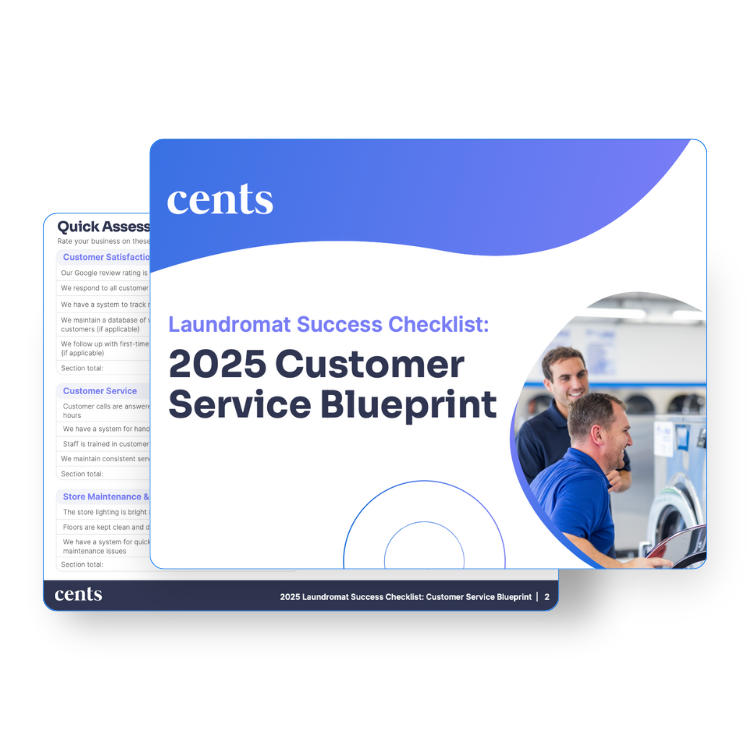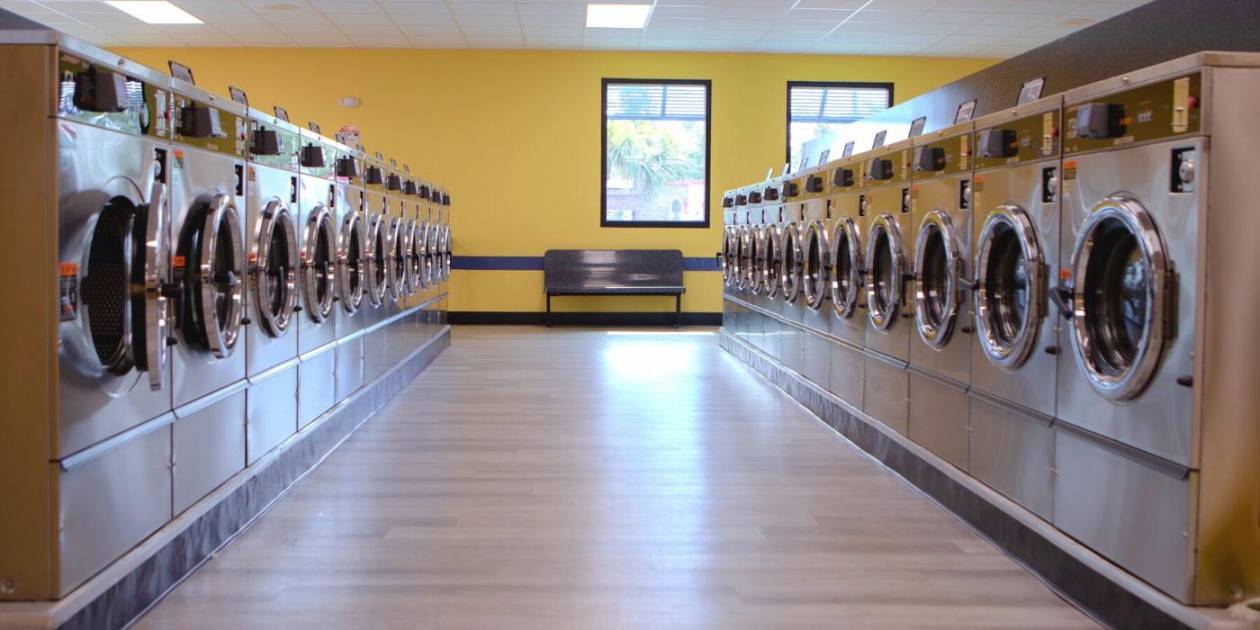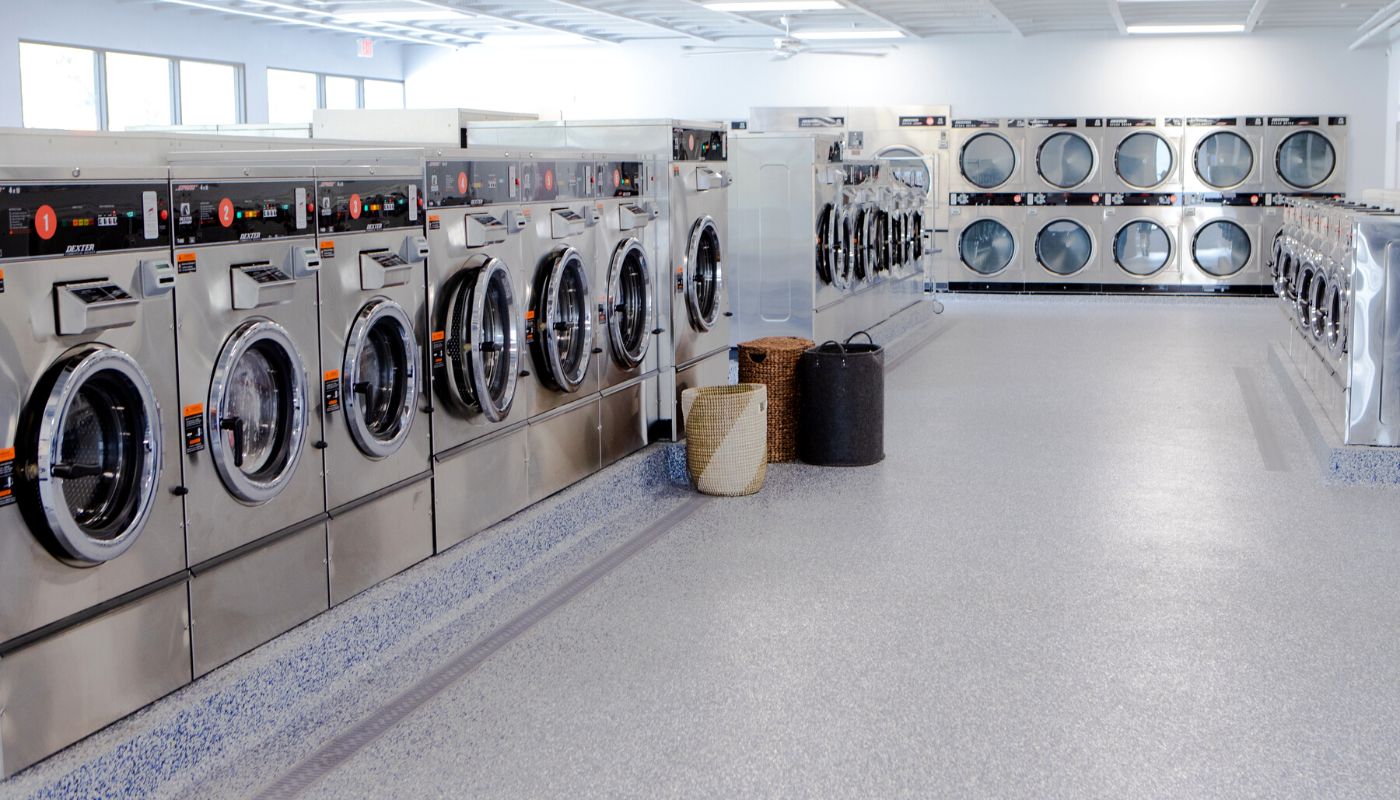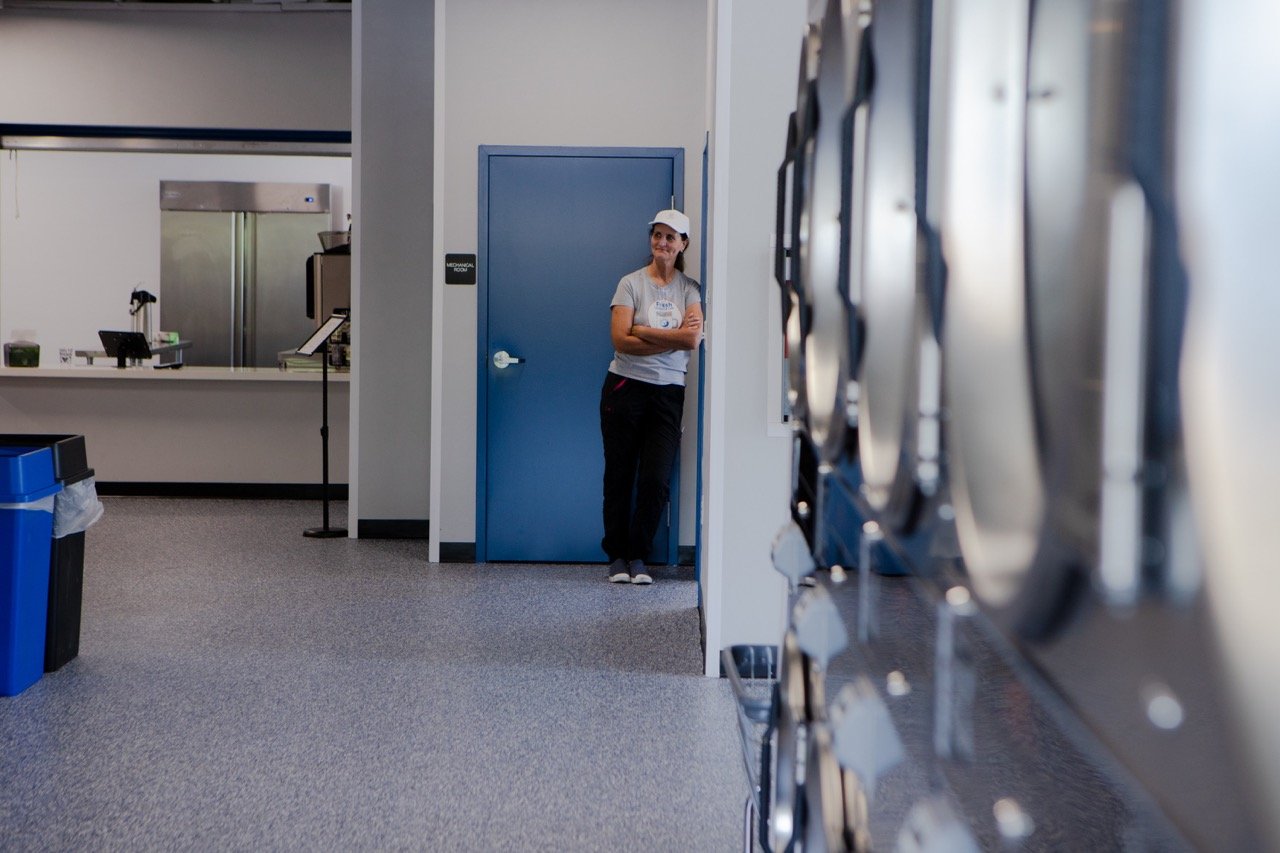The Future of Laundry: Evolving Industry Trends
Laundry services and how they are executed have had to evolve, triggering a new embrace of technology and digitization in laundromat management.
Laundromats post-pandemic
 Laundromats and other laundry service businesses saw a drop in one of the biggest revenue drivers: commercial accounts. As businesses everywhere lost business and staff, there became much less need for commercial laundry services for staff at restaurants, gyms, spas, and similar establishments. In addition, health concerns and lockdowns surrounding in-person services resulted in significant losses for self-service laundromats.
Laundromats and other laundry service businesses saw a drop in one of the biggest revenue drivers: commercial accounts. As businesses everywhere lost business and staff, there became much less need for commercial laundry services for staff at restaurants, gyms, spas, and similar establishments. In addition, health concerns and lockdowns surrounding in-person services resulted in significant losses for self-service laundromats.
In the face of adversity, professionals in the laundry services industry have not thrown in their hats. Despite the challenges the pandemic created, it also opened the industry’s eyes to new possibilities. Laundry businesses examined how they conducted their laundromat operations and found creative and progressive ways to serve their customers and bring in revenue.
We learned how to leverage the power of technology and the gig economy to safely service laundry customers by offering pickup and delivery via rideshare services. Laundry businesses saw an increase in wash-dry-fold and pickup and delivery services as customers demanded more convenience and safety.
Monica Duling, owner of Laundry Liberator, told us, "Laundry as a society needs to move more toward digital systems... We need to be moving the industry to more streamlined methods.”
Monica has done exactly this within her laundry pickup and delivery service: "With our business, we’ve rolled out fully-online booking. You can schedule something at 1:00 a.m., and I’ll show up the next morning.”
The rise of premium laundry services
With the rise of the “small nuclear family”, as well as the single-person household, many individuals are looking for new, convenient options for getting their laundry done. Monica Duling expressed to us, “Moms, dads, and single heads-of-families need that help because their lives just keep getting busier.”
.png?width=479&height=269&name=laundre%20-%20blog%20image%20(1067%20%C3%97%20600%20px).png) This has increased the need for professional cleaning for both convenience and economic benefit with fewer family members. It provides opportunities for self-serve laundromats to scale with the changing economic environments, perhaps going from self-serve only to adding wash-dry-fold services and finally adding pickup and delivery services.
This has increased the need for professional cleaning for both convenience and economic benefit with fewer family members. It provides opportunities for self-serve laundromats to scale with the changing economic environments, perhaps going from self-serve only to adding wash-dry-fold services and finally adding pickup and delivery services.
This is not the only route that laundry businesses can take to incorporate much-needed services to customers. Laundry Liberator, for example, meets people where they are without a brick-and-mortar location. According to Monica Duling, “We only do pickup and delivery. We meet people at a variety of locations, usually at their homes or offices.” They utilize versatile employees and gig partnerships to offer customers the convenience of a laundry service that exists wherever they are.
The Future of Laundromat Management is Here
As of 2024, the U.S. coin-operated laundromat market totaled $6.7 billion, and that number continues to grow. In order to tap into this growth while the industry is hot, owners and managers need to evolve their laundromat management and operation techniques and technologies.
When she purchased KC Laundry, Kathy Tock went right to their customers to discover what they were looking for in a laundromat. Their customers “wanted to be able to pay for their products and their wash and fold with a credit card at the same time,” so KC Laundry immediately integrated a system to meet those needs. “It is a POS system, a way for us to track our wash and fold and to manage from the backend.” Laundry services need to be ready to listen to their customers’ needs and embrace the future of laundromat operations.
Leveraging change
While change can be hard for any business to adapt to, it can also be essential for identifying new avenues of growth. Understanding that the laundry industry is trending in the direction of more expansive services and convenience, owners have the opportunity to leverage that change into new business. Honing in on heightened convenience and customer experience, laundromat owners can enhance their service in a number of ways:
-
Expanding geographical areas: By harnessing the gig economy and online ordering, your laundromat no longer needs to be within a 10-minute radius of customers. With these elements in place, you can promote your laundromat to a larger geographic area, bringing more and different demographics of customers.
-
New market demographics: By expanding your services beyond self-serve laundry, laundromat owners can attract different demographics of customers, including those interested in more convenient and luxury services.
-
Services at higher prices: When it comes to how customers select premium laundromat services, such as wash-dry-fold and pickup and delivery, the decision has little to do with price. Customers want a quality of laundry service better than what they can perform themselves and in a more convenient way, so don’t be afraid to charge a fair price for a luxury service.
-
Commercial opportunities: Now that businesses are back and closer to full staffing capacity, commercial laundry is a great service option to provide laundry businesses with consistent revenue, catering to businesses that need timely and high-quality laundry services.
Leveraging employees
 As your laundromat management evolves, so should your employee management techniques. These individuals are the face of your business, so understanding how to successfully hire, train, and retain them as your business grows is essential to its success. It’s important to maintain a human connection with your customers, and your employees are an essential way to do this. According to Monia Duling, “Laundry is personal — so are we. Keep a grasp on that personal nature.”
As your laundromat management evolves, so should your employee management techniques. These individuals are the face of your business, so understanding how to successfully hire, train, and retain them as your business grows is essential to its success. It’s important to maintain a human connection with your customers, and your employees are an essential way to do this. According to Monia Duling, “Laundry is personal — so are we. Keep a grasp on that personal nature.”
For the Laundry Liberator, “[Hiring] has been a struggle but also a turning point in realizing that the effort of getting people adjusted to this unique kind of business is worth it.” In order to effectively leverage your employees, you need to put in the time and effort with training and streamlined processes.
One of the most effective ways to simplify and streamline your employee experience is to integrate a laundromat management system that supports them, rather than holding them back. According to Kathy, “My attendants don’t need to pick up the phone and call a customer to tell them their laundry is ready for pickup. They can do it all with the click of a button.”
Maintaining an environment in which your staff has control over their output and the ways they communicate with customers, the more opportunity they have to take the initiative in their success, the more satisfied they are in their work, and the more likely they are to stick around.
Leveraging data
One of the most crucial ways for owners to stay ahead of the curve and be prepared for the future of the laundry industry is to understand the data. This not only includes the larger scope of data about the industry as a whole but data collected about your business and its performance within your current markets. With the right laundromat management system in place, owners can gather and analyze important metrics, including:
-
Total revenue
-
Total revenue by service type
-
Total revenue per machine
-
Machine operation costs
-
Average order value
-
Debts
Collecting and analyzing this kind of data is a game-changer for laundry business owners, as it helps to evaluate existing processes for optimization opportunities and make informed decisions for the improvement of your laundromat operations.
1. Total gross revenue
Laundromat owners should be calculating daily, weekly, and monthly revenue. This not only helps you understand how much revenue you’re generating but also pinpoints which days are the slowest so you can work on optimizing them.
Weekly and monthly revenue will help you better gauge overall revenue, and the daily will help you account for any slow days or peak performance periods. Knowing daily revenue can also help you when offering promotions. If revenue is low one day of the week versus another, you can offer incentives to entice customers to do laundry on less-busy days.
Keep in mind, you don’t want to look too closely into the daily monitoring. Constantly reviewing those numbers can lead to an obsession with those down days that could be caused by factors outside of your control.
2. Total revenue by service type
If you offer multiple services at your laundromat, it’s important to track the total revenue generated by each service. This way, you’ll be able to determine the profit by segment and track how well a service is performing. This can include:
-
Self-Service
-
Wash-Dry-Fold
-
Pickup and Delivery
If one of them is not generating enough profit, it could mean there is local competition or a pricing issue. With this information, you can make the right move for your business whether that be more marketing or other solutions.
3. Total revenue per machine
Calculating the total revenue per machine by size and location in the store can help analyze the store’s prime equipment placement location and favorite washers. Knowing these numbers can help you make decisions about where to place certain machines to maximize performance and boost potential revenue.
Different machines and cycles will bring in different amounts of revenue. The revenue you bring in for various machines can help you determine if you need more machines that bring in more revenue or need to get rid of the ones that are bringing in the least amount.
This can also help determine if charging for additional cycles is profitable, like a sanitation cycle. You’ll be able to drive additional revenue by informing customers about the cycle availability and benefits of specialty cycles. Another important part of calculating the revenue per machine is to calculate the turns per day. This number tells you how much laundry is being processed per day by each machine.
By monitoring this metric weekly and monthly, you can look for trends in the data and identify any ebbs and flows of the business. Monitoring turns per day can also help you pinpoint slow periods and where there is an opportunity to boost traffic with promotions and drive consistency. A common rule of thumb is to shoot for three turns per day.
4. Machine operation costs
Conducting regular machine audits is crucial to controlling costs within your laundromat. By tracking error codes, service requests, and maintenance by machine, you can spot patterns in the frequency of these types of alerts and get to the bottom of a root cause.
It’s important to keep track of:
-
How many times has a machine been out of order
-
The associated costs with repairs
-
Revenue lost for machine downtime
For coin-operated laundromats, machine audits should tie in with the collection frequency. Those using hybrid and card-operated stores most likely have access to software for revenue reporting and management automation to keep track of the machine operation metrics.
Other metrics to look at for machine operations costs are the error codes that pop up on machines. These codes can be a result of something simple like an unbalanced load, or they can be an indication of a problem that requires professional services. Monitoring messages and maintenance by machine or group of machines will help you notice issues and problems with equipment sooner so that you can better troubleshoot a solution.
5. Average order value
If you offer services like Wash-Dry-Fold and Pickup and Delivery, it’s important that you determine what the average order value is for these segments.
Knowing your laundromat’s average order value helps you evaluate your pricing strategy and marketing efforts, providing you with the metrics needed to measure the long-term value of individual customers. Average order value serves as a benchmark for your customers’ laundry behavior, which helps with goal setting, strategy enhancement, and evaluation of current business strategy. When you know the average order value, you can improve upon it, directly improving profit and revenue growth.
Knowing the average order value also offers a window into your laundromat customers’ behaviors and how much they spend at your business. When you understand what they spend per Wash-Dry-Fold or Pickup and Delivery order, you can plan pricing and marketing to improve.
To calculate the average order value, you’ll need to add the total revenue and divide it by the total number of orders placed in a given period.
6. Debts
Tracking your laundromat’s fixed and variable costs will help you gauge and document the laundromat’s profitability. As an operator, you’ll be able to identify and react to opportunities and issues quicker than waiting for the problem to present itself.
Fixed costs include consistent costs that do not change month-to-month. This includes numbers like insurance, debt service, rent, and any services you use to enhance your laundromat experience like TV.
Variable costs include utilities and labor. Utility costs make up a significant part of recurring costs for owners. Managing energy and water costs is a good way to control your overall expenses. To identify if your utilities are eating up too much revenue, take about 15-20% of your gross revenue. If they exceed this number, investigate why.
-
Is there a leak?
-
Are there problems with the infrastructure or utility?
-
Is it time to replace your equipment with higher-efficiency options?
You should also investigate if your utilities are in line with your revenue. For example, if there is a spike in the water bill for one quarter, and the revenue doesn’t show an increase in usage, this could indicate a problem with how water usage is being calculated or a plumbing issue within the infrastructure.
Future Laundry Technology: How Digital Tools are Transforming Laundromats
Future laundry technology is no longer a distant concept; it’s here now, transforming laundromat operations with innovations that prepare businesses for the evolving demands of the laundromat future.
Speed
Improving the speed of your laundromat operations is not only about going faster — it’s about the acceleration of business tasks without sacrificing quality or losing insights.
Owner benefit: By embracing digital elements of laundromat management, owners and their team can complete tasks much faster than with manual techniques without losing quality.
Customer benefit: Whether utilizing self-serve or pickup and delivery through your app, customers can get laundry done much faster with better hardware, software, and connectivity.
Convenience
 For laundry business owners, convenience comes in the form of flexibility in how and where they work. By integrating a sophisticated laundromat management system into your laundromat operations, owners can have the flexibility and convenience to perform business tasks from anywhere.
For laundry business owners, convenience comes in the form of flexibility in how and where they work. By integrating a sophisticated laundromat management system into your laundromat operations, owners can have the flexibility and convenience to perform business tasks from anywhere.
Owner benefit: Rather than manually organizing inventory data, employee performance numbers and other important information, laundromat management technology conveniently collects, analyzes, and centralizes everything for you in one location, giving owners the ability to complete tasks from anywhere at any time.
Customer benefit: That same convenience and flexibility are important to laundry customers. Digital laundromat capabilities provide the convenience of paying with a credit card in-store or placing orders online and having their laundry picked up and delivered right back to their front doors.
Geography
Within such a locally-driven industry, laundromat owners rely heavily on the customers within a specific geographic radius. Incorporating digital elements makes it much easier for laundry business owners to expand the areas in which they can gain new customers.
Owner benefit: Centralizing all business information into one digital location makes it much easier for laundromat owners to expand to multi-store locations, offer pickup and delivery services within a broader geographic radius, and gain customers within new and different demographics.
Customer benefit: When laundromats expand the area in which they operate, it provides increased laundromat options customers can choose from. Even if a laundromat is a little bit further away than they would prefer, customers will pay a higher price point for premium, high-quality services such as wash-dry-fold or pickup and delivery.
Control
While many get into the laundry business for passive income, Kathy will tell you, “It’s anything but passive.” In order for laundromat business owners to truly reap the benefits of the industry, they need to have complete control over every element of their operations.
Owner benefit: With eyes on every step of business operations, owners have much greater and more direct control over data that’s collected and how it is used, empowering them to make better-informed business decisions and improve their laundromat management.
Customer benefit: With digitization comes greater power for the customer to choose how and when their laundry is done, whether they choose to do their laundry themselves with self-service or have their laundry picked up, washed, dried, folded, and delivered to their doors.
Cents' All-in-One Laundromat Management System
By aggregating all employee, customer, financial, and location data into one centralized place, laundromat business owners can enter into a new and empowering understanding of their business. Cents offers the all-in-one laundromat management system that empowers laundromat owners and operators to effectively manage every element of your laundromat, including:
-
Employees in every store
-
Varying demographic customer behaviors
-
Financial activity
-
Multi-store locations
-
Operations and performance
Emerging Trends in Future Laundry Technology
The laundry industry is at the forefront of a technological revolution, driven by innovations designed to enhance efficiency, sustainability, and customer convenience. As laundromats continue to evolve, embracing cutting-edge technologies is becoming essential to remain competitive and meet the needs of modern consumers. Below are some of the most significant trends shaping the future of laundry technology.
Contactless Payment Systems
With the rise of cashless societies, contactless payment systems are becoming a standard feature in modern laundromats. Whether through credit cards, mobile payment apps, or NFC-enabled devices, customers now have more flexibility and convenience when paying for laundry services. These systems streamline operations for owners while enhancing the customer experience.
Energy-Efficient Machines
Sustainability is a growing concern across industries, and the laundry sector is no exception. High-efficiency washers and dryers that use less water, energy, and detergent are gaining traction. Machines with advanced sensors can optimize water levels and cycle times based on the load size, reducing resource wastage while maintaining excellent cleaning performance.
Eco-Friendly Practices
Beyond energy-efficient machines, laundromats are embracing eco-friendly practices like using biodegradable detergents, water recycling systems, and renewable energy sources. Solar-powered laundromats and those equipped with heat recovery systems are leading the way in reducing the industry's environmental impact.
AI and Machine Learning
Artificial intelligence and machine learning are revolutionizing laundromat management. These technologies enable predictive maintenance, ensuring machines are serviced before breakdowns occur, reducing downtime and repair costs. AI can also help optimize pricing strategies and customer engagement by analyzing trends in user behavior and preferences.
Laundry-as-a-Service (LaaS)
The gig economy and on-demand services have introduced the concept of Laundry-as-a-Service (LaaS), where customers can schedule pickups, deliveries, and even subscription-based laundry plans. This model is fueled by digital platforms and apps, offering convenience for busy individuals and families while expanding revenue streams for laundromat businesses.
By leveraging these emerging technologies, laundromats can cater to the growing demand for efficient, sustainable, and customer-friendly services, ensuring they stay ahead in a competitive and evolving market.
Bring Your Laundromat Operations into the Future with Cents
The future of laundry is booming with possibilities for laundromat owners to embrace. In order to harness those opportunities to their fullest extent, owners need their laundromat management and operations techniques and technologies to evolve and scale with their business and the industry. To learn more about how Cents’ all-in-one laundromat management system can transform your business, schedule a demo today.
Grow your market, tap into new revenue sources, or update the customer experience. Whether you have one store, multiple stores, or just getting started in the industry, Cents has the one system you need to grow, manage, and understand your business.
.png)

-3.png)








